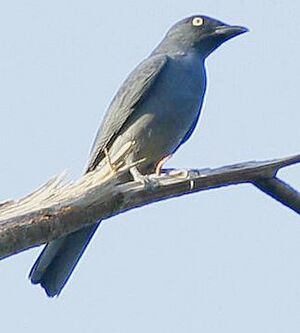Bar-bellied cuckooshrike facts for kids
Quick facts for kids Bar-bellied cuckooshrike |
|
|---|---|
 |
|
| Mount Makiling, Philippines | |
| Conservation status | |
| Scientific classification | |
| Genus: |
Coracina
|
| Species: |
striata
|
The Bar-bellied Cuckooshrike (scientific name: Coracina striata) is a type of bird that belongs to the family Campephagidae. You can find these birds in countries like Thailand, Malaysia, Indonesia, and the Philippines. They like to live in different kinds of habitats, such as mangrove forests, dry forests, swampy forests, and even forests that are growing back after being cut down.
The feathers of these birds can look different depending on where they live. Some have more stripes on their bellies than others. The International Union for Conservation of Nature (IUCN) says that this bird is a "least-concern" species. This means it's not currently in danger of disappearing.
Contents
Meet the Bar-bellied Cuckooshrike
This bird was first described by a French scientist named Georges-Louis Leclerc, Comte de Buffon in 1775. Later, in 1783, a Dutch naturalist named Pieter Boddaert gave it its scientific name, Corvus striatus. The name Coracina comes from an old Greek word meaning "little raven." The word striata is Latin and means "striped," which describes some of these birds.
Today, the Bar-bellied Cuckooshrike is part of the Coracina group of birds. There are many different kinds of Bar-bellied Cuckooshrikes, called subspecies. These subspecies can look a bit different from each other. For example, one subspecies that used to live on Cebu island is now extinct.
What Does It Look Like?
The Bar-bellied Cuckooshrike is about 24 to 32 centimeters (about 9 to 12 inches) long. Their size and feather patterns can change a lot.
In the Philippines, some subspecies are mostly grey. The male birds might have some black on their heads. Other subspecies have males with faint stripes on their lower backs. The females often have black and white stripes on their bellies.
In places like the Thai-Malay Peninsula, the males are grey on top. They might have some stripes on their lower back and tail feathers. The females in these areas have stripes on their underparts, reaching up to their chest. Young birds often have stripes all over their undersides.
Where Do They Live?
You can find the Bar-bellied Cuckooshrike in the Thai-Malay Peninsula, Sumatra, Borneo, and the Philippines. They also live on many smaller islands nearby. Sadly, they disappeared from Singapore around the late 1960s.
These birds prefer to live in low-lying areas. Their favorite homes include mangrove forests, dry forests, and freshwater swamp forests. They also live in forests that are growing back, and sometimes in bushes or plantations.
How Do They Behave?
Bar-bellied Cuckooshrikes often live in small groups. Sometimes, they join bigger groups of different bird species to look for food. They mostly eat insects, like caterpillars, mantises, and dragonflys. They also enjoy eating figs.
These birds make various sounds. You might hear a harsh "klee kleep" or a whistling "keeuk-keeuk." They also make sounds like "sic sic sic," "tliu k'liu," and a whinnying "kliukliukliu."
They usually build their nests in April and May. Their cup nests are made in the fork of a tree. They use things like moss, lichens, leaves, and small roots. The eggs are grey with lavender and reddish-brown marks.
Are They Safe?
The Bar-bellied Cuckooshrike lives across a very wide area. The total number of these birds seems to be going down because their homes are being destroyed. However, the population is not dropping too quickly. Because of this, the IUCN Red List has listed them as a least-concern species. This means they are not in immediate danger. But in the Thai-Malay Peninsula, they are considered more vulnerable.


